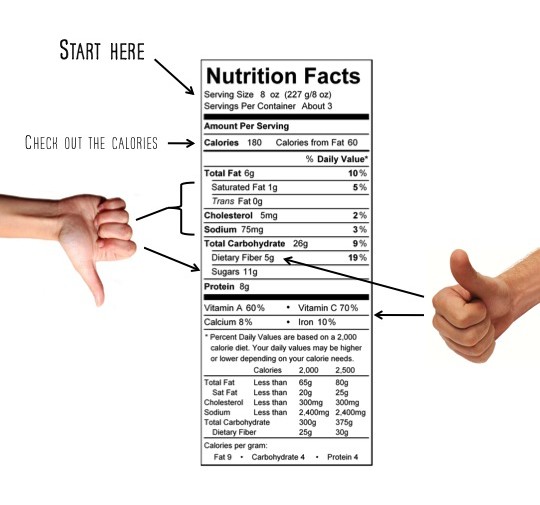So here we go…how to read a nutrition label. One of the (admittedly) more dull things to blog about, but important enough to try.
A quick note before I start: If you just want the nuts and bolts of nutrition label reading, skip over the “more info” bullets. They provide “nice to know” detail, but not necessarily “need to know” information. Also, remember tomorrow I’ll be sharing a chart showing what you should pay attention to within particular classes of food. For example, saturated/trans fat and sodium are important to consider when comparing snack foods like crackers, pretzels, etc., while fiber and sugar content should be more of a focus when comparing cereals.
Grab a cup of coffee and let’s get to it….
 1. The first place to start is “Serving Size,” which is always listed directly under the words “Nutrition Facts.” All of the numbers on the rest of the label are based on this value. If you eat two servings, you have to double the rest of the values. (Side note: Yes, this is what tripped up my husband.)
1. The first place to start is “Serving Size,” which is always listed directly under the words “Nutrition Facts.” All of the numbers on the rest of the label are based on this value. If you eat two servings, you have to double the rest of the values. (Side note: Yes, this is what tripped up my husband.)
2. Check out the calories. Knowing that most people eat between 1500-2500 calories a day, you can see how this food fits into your calorie “budget.”
More info: Generally meals should contain ~400-600 calories and snacks should be less than ~250 calories. Pay extra close attention to foods that contain loads of calories but not much nutritional value otherwise like sugary drinks. Avoid them.
3. Minimize saturated and trans fat, sodium, and sugar.
More info on saturated and trans fat: Ignore “Total Fat” and look below to the numbers next to “Saturated Fat” and “Trans Fat.” These are the only fats that adversely affect your heart health. Both saturated and trans fat raise your LDL cholesterol (aka the Lousy kind), but trans fat is the real bad boy because it also lowers your HDL cholesterol (aka the Healthy kind). Unfortunately, it gets even trickier. A food company is allowed to claim a product has zero trans fat on the label if it has less than 0.5 g per serving. To really make sure a product is trans-fat free, you must look to the ingredients list and check to see whether the word “partially hydrogenated” pops up anywhere. If it does, the product does in fact contain trans fat. If you’re eating one serving, you might be okay but if you’re eating two or more servings, that small amount of trans fat can quickly add up.
More info on sodium: Americans consume too much salt and over 75% of it comes from eating packaged and restaurant foods. The best way to gauge whether a food has too much salt is to look at the Percent Daily Value (%DV). While the %DV is generally useless because it’s based on a 2000 calorie diet and many of us need to eat more or less than that, the %DV for sodium is based on 100% of the recommended amount of sodium for the vast majority of us, which is less than 2400 mg per day. A rule of thumb is
- 5%DV (120 mg) or less of sodium per serving is low – Go for it!
- 20%DV (480 mg) or more of sodium per serving is high – Think twice!
More info on sugar: Another tricky one. Nutrition panels don’t distinguish between added sugar – what we want to minimize – and naturally occurring sugar. Naturally occurring sugar can be found in all dairy (lactose), fruit (fructose), grains and starchy vegetables (glucose). That’s why the grams sugar is useful when comparing products (e.g. plain yogurt versus flavored yogurt), but not necessarily useful on its own. To make sure a product is not high in added sugar, you’ll need to check the ingredients list. Ingredients are listed by weight. The farther up sugar falls on the list, the more added sugar there is. Also look for code words that are just sugar in disguise: cane/beet sugar, sucrose/fructose/lactose/maltose, molasses, maple syrup, agave nectar, etc.
4. Maximize fiber and vitamins and minerals.
More info: Nah, enough said.
Now that you’ve gotten the rundown, go back to the food labels that I asked you look at yesterday. Did you first look at serving size? Did you get side tracked with less important info like total fat or cholesterol? Still confused about what information is most important with your particular class of food? Don’t worry, I’ll be back tomorrow to help with that.